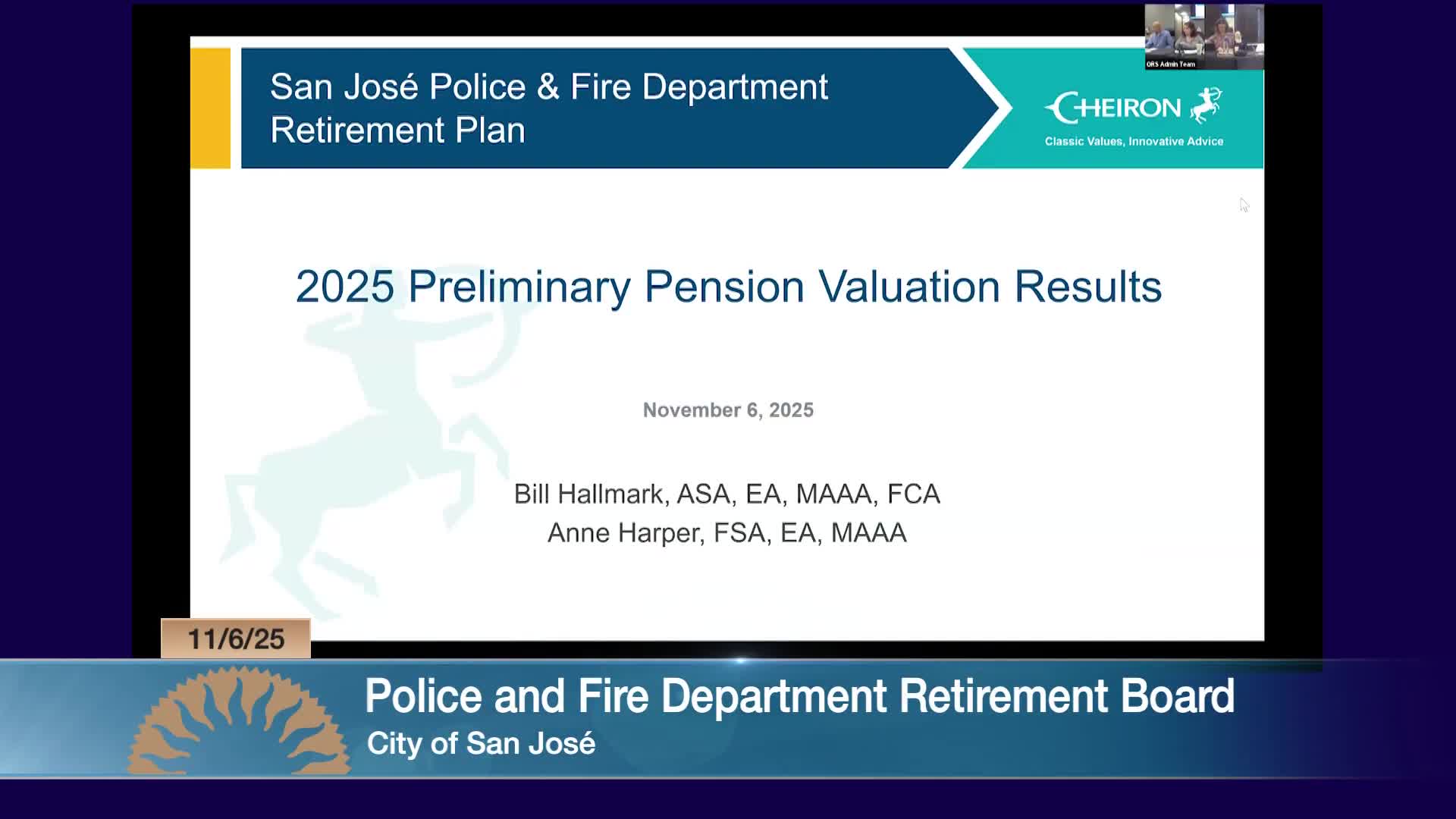San Jose board adopts demographic assumption updates; sets wage-inflation assumption at 3.125%
November 08, 2025 | San Jose , Santa Clara County, California
This article was created by AI summarizing key points discussed. AI makes mistakes, so for full details and context, please refer to the video of the full meeting. Please report any errors so we can fix them. Report an error »

The Board of Administration for the City of San Jose Police and Fire Retirement Plan voted to adopt updates to demographic assumptions used in the actuarial valuation and set the wage-inflation assumption at 3.125% for the upcoming actuarial valuation.
Actuarial staff presented preliminary results that showed the plan's accrued liability just over $6.4 billion and noted an improvement in funded status in 2025: market-value and actuarial-value funded ratios both rose versus the prior valuation. Presenters said the actuarial (smoothed) unfunded accrued liability declined from about $1.1 billion to roughly $1.0 billion after smoothing and recognizing recent investment gains; actuarial staff attributed the remaining liability experience losses primarily to salary increases above prior assumptions.
The board reviewed a demographic experience study that proposed modest changes to merit-salary scales, retirement rates, termination rates, disability assumptions and a change to the Society of Actuaries' public-sector mortality table (move to PUB-2016). Actuaries explained their approach: a 10-year rolling experience window, confidence intervals and fit statistics to avoid overreacting to short-term variation.
On motions recorded in the meeting, the board "accept[ed] the results and assumptions as presented" for the demographic study (motion moved by Moozli; seconded by Gretchen; vote recorded in the meeting as in favor). The board separately voted to set the wage-inflation assumption at 3.125% (motion by Lusby; seconded by Eswar), a compromise choice among alternatives staff had shown (3.0%, 3.125%, 3.25%). Staff told trustees the 3.125% assumption better balances the city’s current budget sensitivity with longer-term compensation expectations.
Actuarial staff also noted policy considerations: privatе-market allocations are increasing the plan's management-fee ratio because private funds charge fees on committed capital, and a board decision to increase private allocations in prior years contributed to higher 2024 management fees now being observed. Trustees asked for and were told that detailed counts of tier 1 and tier 2 retirees and spouse beneficiaries would be included in the final valuation report.
The motions passed during the meeting were procedural decisions to set assumptions for the December final valuation; the board did not adopt new benefit legislation at the session.
Actuarial staff presented preliminary results that showed the plan's accrued liability just over $6.4 billion and noted an improvement in funded status in 2025: market-value and actuarial-value funded ratios both rose versus the prior valuation. Presenters said the actuarial (smoothed) unfunded accrued liability declined from about $1.1 billion to roughly $1.0 billion after smoothing and recognizing recent investment gains; actuarial staff attributed the remaining liability experience losses primarily to salary increases above prior assumptions.
The board reviewed a demographic experience study that proposed modest changes to merit-salary scales, retirement rates, termination rates, disability assumptions and a change to the Society of Actuaries' public-sector mortality table (move to PUB-2016). Actuaries explained their approach: a 10-year rolling experience window, confidence intervals and fit statistics to avoid overreacting to short-term variation.
On motions recorded in the meeting, the board "accept[ed] the results and assumptions as presented" for the demographic study (motion moved by Moozli; seconded by Gretchen; vote recorded in the meeting as in favor). The board separately voted to set the wage-inflation assumption at 3.125% (motion by Lusby; seconded by Eswar), a compromise choice among alternatives staff had shown (3.0%, 3.125%, 3.25%). Staff told trustees the 3.125% assumption better balances the city’s current budget sensitivity with longer-term compensation expectations.
Actuarial staff also noted policy considerations: privatе-market allocations are increasing the plan's management-fee ratio because private funds charge fees on committed capital, and a board decision to increase private allocations in prior years contributed to higher 2024 management fees now being observed. Trustees asked for and were told that detailed counts of tier 1 and tier 2 retirees and spouse beneficiaries would be included in the final valuation report.
The motions passed during the meeting were procedural decisions to set assumptions for the December final valuation; the board did not adopt new benefit legislation at the session.
Don't Miss a Word: See the Full Meeting!
Go beyond summaries. Unlock every video, transcript, and key insight with a Founder Membership.
✓
Get instant access to full meeting videos
✓
Search and clip any phrase from complete transcripts
✓
Receive AI-powered summaries & custom alerts
✓
Enjoy lifetime, unrestricted access to government data
30-day money-back guarantee

